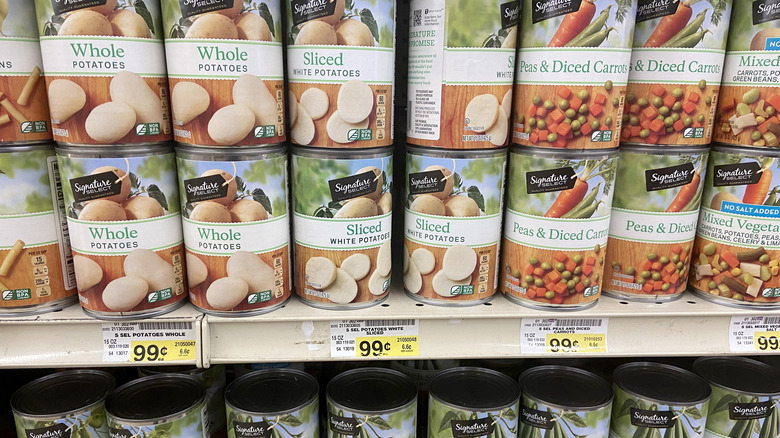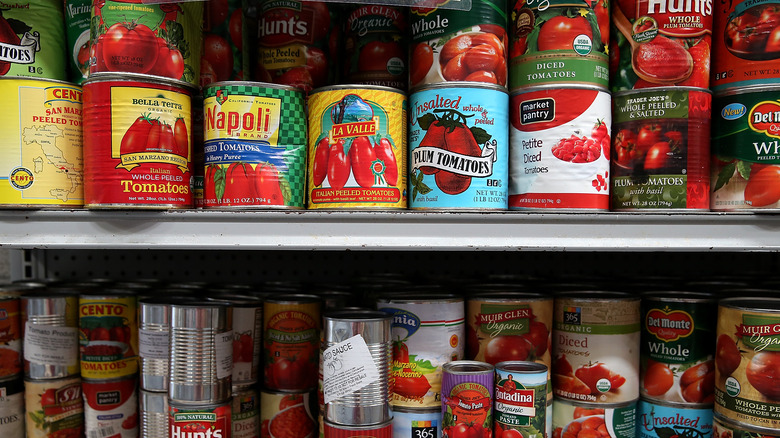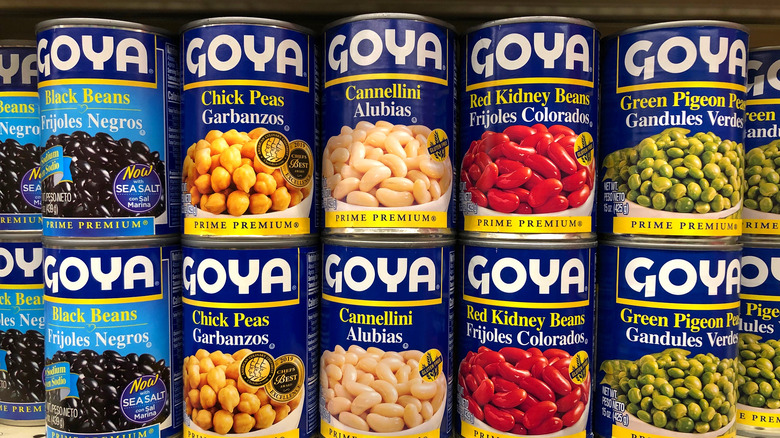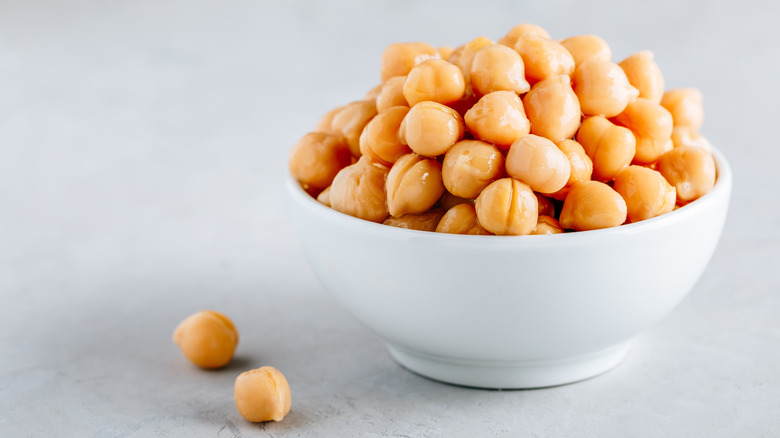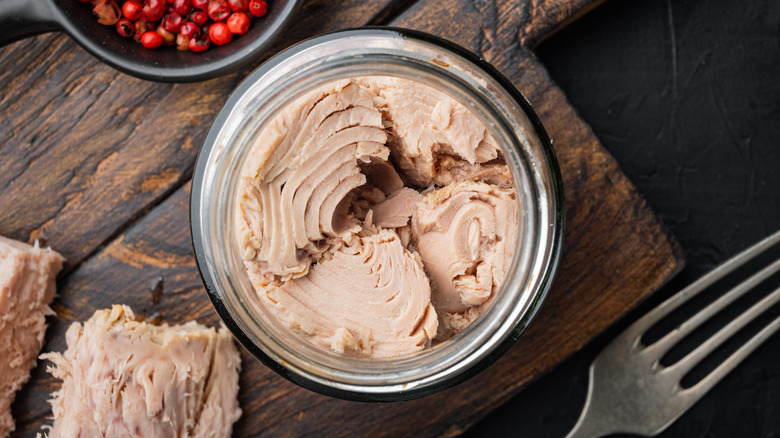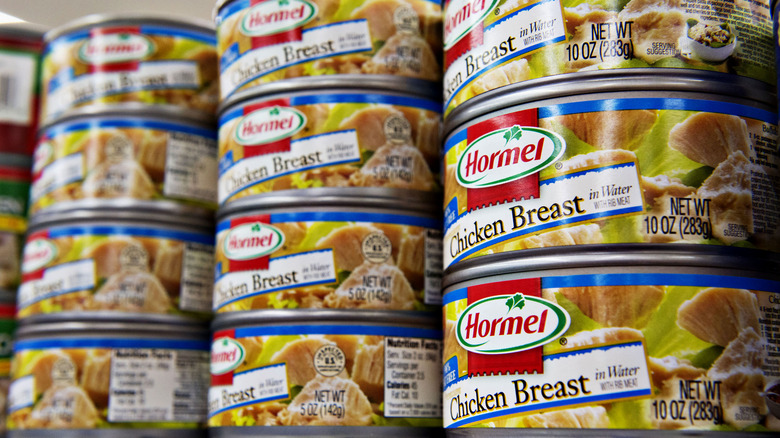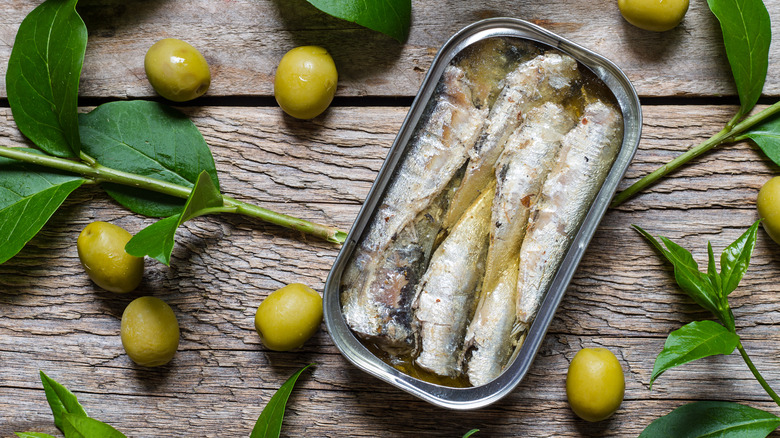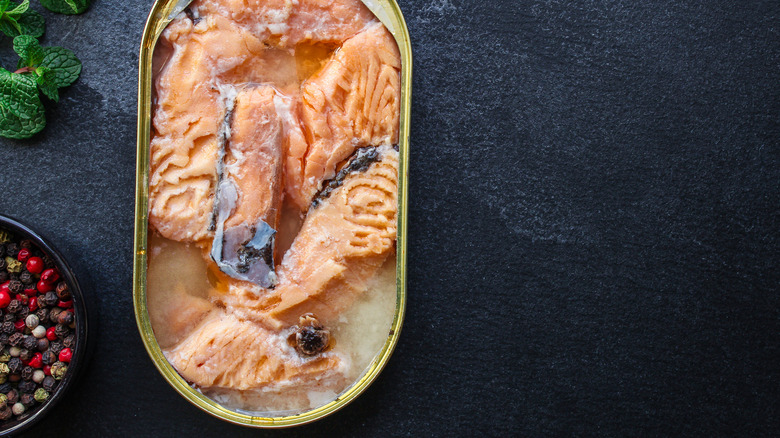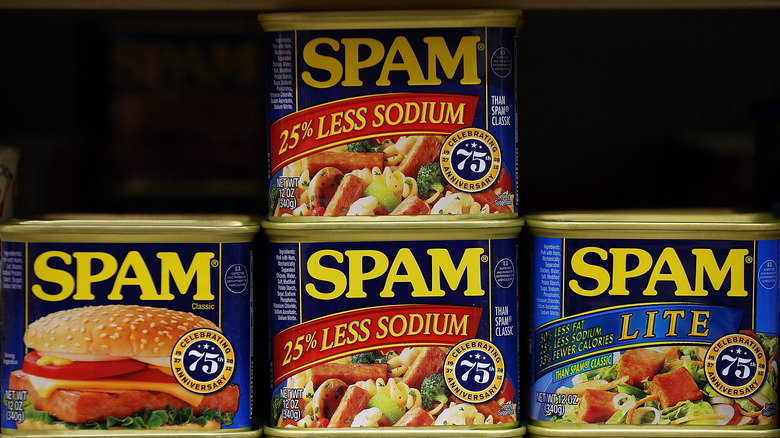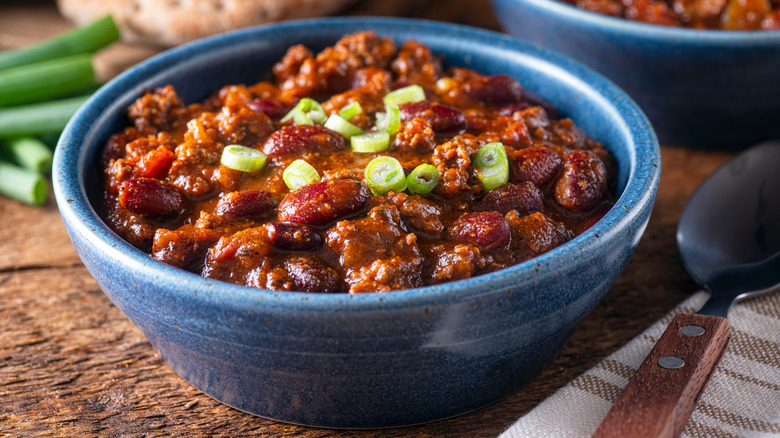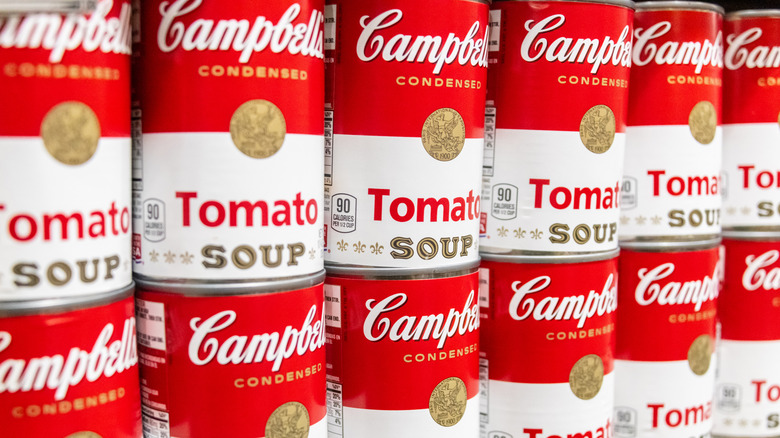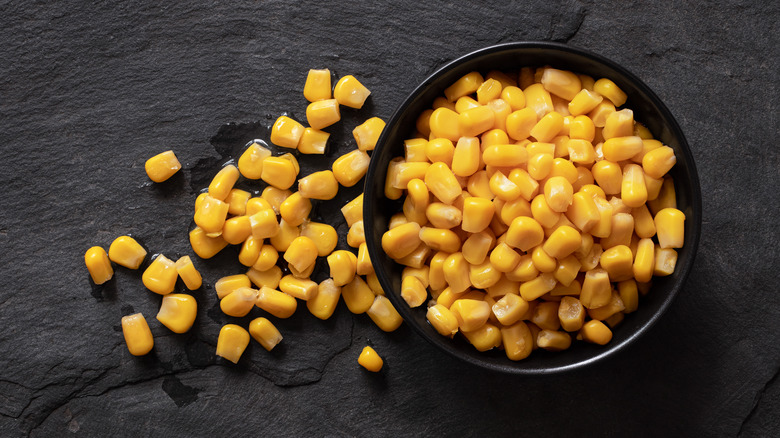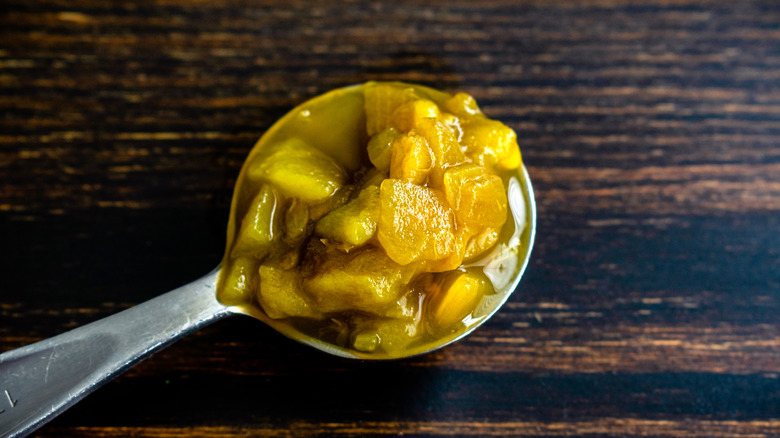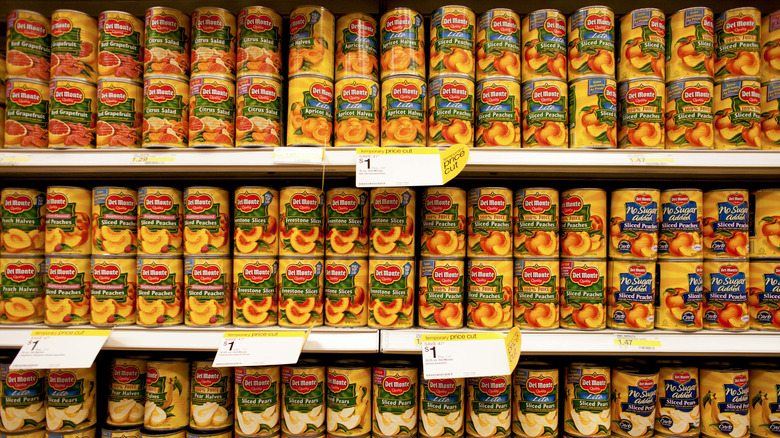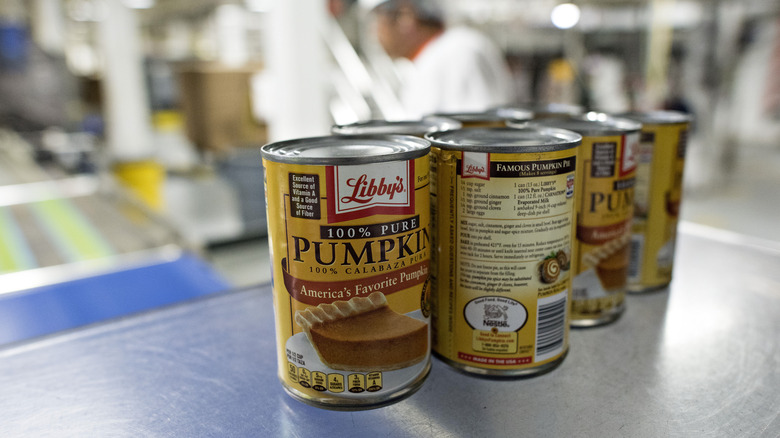The 15 Absolute Best Canned Foods To Stock Your Pantry
We may receive a commission on purchases made from links.
You don't need to be prepping for the apocalypse in order to stock your pantry. A well-appointed cupboard increases your chances of having the exact ingredients you need whenever you're ready to whip up your next amazing meal — no trip to the grocery store required. After all, there are some occasions where you just need to get dinner on the table quickly, and you have no energy or time to make a grocery run; you don't want to be caught unawares and with empty cabinets when it happens.
That's where canned goods come in handy. Per Britannica, canned food has been around since the early 1800s, and while the process sure has evolved over the years, the goal hasn't changed too much: Preserve food so that it can be stored for an extended amount of time.
So, where do you start with stocking up? Which canned foods are going to actually pull their weight, proving useful enough to buy in bulk (or even just a few extra cans at a time)? Here are our picks for the best canned foods that will nearly always come in handy, even when you least expect it, and which are well worth using up some of that valuable pantry space.
1. Tomatoes
Diced, crushed, whole, sauce, paste — however you prefer 'em, canned tomatoes can come in handy. How many cuisines and popular favorite dishes require a simple, humble can of tomatoes, in some form or another? Whether you frequently throw together some homemade pizzas, make your own pasta sauce, or simmer a soup on the stovetop, you likely reach for a can of tomatoes.
However, if you want to make the most of your canned tomatoes, there's one simple trick. Instead of draining your diced or whole tomatoes, keep the juice. You can use leftover canned tomato juice to thin out soups and sauces, or add it to rice. As for what type of canned tomatoes to buy, one breed and one brand stand apart from all the rest, with nods of approval from the likes of Martha Stewart and Ina Garten: San Marzano plum tomatoes (known for their great flavor and few seeds). As Garten's penne arrabiata recipe states definitively, "I think San Marzano are the best quality of tomatoes." Her go-to brand is Simpson Imports' San Merican tomatoes.
2. Beans
Canned beans are far more convenient than dried beans. Soaking overnight and then simmering all day? Who has time for that? If you definitely do not, stock your pantry with several varieties of canned beans, so you have some on hand for all the different dishes that come together quickly and easily once you pop the top off. From soups to chili and salads to nachos, beans add a little extra protein, texture, and nutrition to any meal.
However, whatever type of beans you stock up on, you'll want to take into consideration a few things to get the most out of your purchase. For example, don't necessarily always hold true to that "rinse your beans" rule. If you're watching your sodium, sure, rinse and drain the liquid from your can of beans. If, though, your dish needs a little extra liquid and some starch, keep that liquid and use it.
3. Chickpeas
Yes, you can technically consider chickpeas a bean, but whether or not you stock your pantry with run-of-the-mill bean varieties like black beans or pinto beans, chickpeas deserve their own, distinct spot in your kitchen cabinets. Not only do canned chickpeas eliminate the lengthy soaking and cooking process required when cooking dried chickpeas (hello, hummus in mere minutes!), but canned chickpeas come with an extra-special side ingredient that may come in handy elsewhere in your kitchen: aquafaba, the liquid found in each can of chickpeas.
Aquafaba is an alternative to eggs that can work for vegans and people with egg allergies. You can use this liquid to create a variety of sweet and savory, delicious recipes that are otherwise basically impossible without eggs (or, in this case, aquafaba). Think meringues, mousses, and more. Whenever you use your chickpeas for hummus, salads, or side dishes, just reserve the aquafaba and set it aside for future use. Once you see how the liquid puffs up with just a little cream of tartar into gorgeous meringue peaks, you'll be glad you did.
4. Tuna
While not everyone's a fan, there are a few instances where you might reach for canned tuna instead of the packed or raw stuff. If you're making tuna salad or a tuna melt — think dishes that incorporate strong flavors beyond the taste of the tuna itself — canned tuna is incredibly convenient.
But, if you're not convinced merely by the convenience factor, there are a few upgrades and ways to use your canned tuna that might just sell you on this pantry staple. If you have a little extra time, you can upgrade your canned tuna by sautéing it in a bit of olive oil and garlic powder (in fact, you might find you like it so much afterward that there's no need for adding mayo to your favorite tuna salad recipe). Albacore is a popular option for its taste and some health aspects — WebMD notes, it packs higher levels of omega-3 fats — but it also boasts mercury levels three times as high in albacore as those in light tuna. Per recommendations, canned tuna should only be consumed a few times a month, but if you're particularly concerned about mercury, light is the better option.
5. Chicken
Canned chicken, much like canned tuna, has its fans and its foes. Sure, canned chicken may not be as delicious as a freshly-pulled chicken breast, slow-roasted to perfection, but canned chicken is 100% more convenient and just as tasty if you're putting together the right recipes.
When stocking up on canned chicken, keep a few things in mind. Firstly, pick one of the better-ranked canned chicken brands, such as Kirkland Signature Premium Chunk Chicken Breast, which is known to be one of your more tender, moist, and flavorful options. Other favorite options include Hormel Premium No Salt-Added Canned Chunk Chicken Breast in Water and Sweet Sue Chunk White Chicken in Water.
Additionally, consider that when you stock up on canned chicken, you have with a lot of time to use it: Canned chicken can last up to five years in your pantry. So, there's no rush to force a can into a recipe where it might not be a good fit.
6. Sardines
Sardines truly are one of the superior canned fish options (and, really, when's the last time you spotted fresh sardines at your local big-box grocery store?). If you're not already a sardine fan, it's time you acquainted yourself with this salty, little, versatile fish. You can add sardines to your tuna salad for an oilier, richer, fattier flavor profile. Sardines in bucatini pair well for an impressive alternative when you're craving Italian, but also something fancier than spaghetti.
When shopping for canned fish brands, look to some of our favorite: Bela packs its sardines in lemon extra virgin olive oil. Jose Gourmet offers Portuguese sardines in tomato sauce. And Jacques Gonidec makes sardines in an onion sauce. If you do decide to try sardines and begin adding this fish to your pantry on a regular basis, you won't be alone. Canned fish has been trending since the start of the Covid-19 pandemic.
7. Salmon
Canned salmon is affordable, convenient, and nutritious — and that latter fact is what might make canned salmon a better fit for your pantry over canned tuna. However, nutrition aside, canned salmon is incredibly versatile and an easy addition to salads, egg-based dishes, or some tasty fish cakes. You can also eat canned salmon straight out of the can on crackers with some lemon juice, salt, and pepper.
One of the standards types of salmon in cans is pink salmon, a common species found in the Pacific. Pink salmon isn't as oily as some of the other salmon species, and the fish are usually smaller. Pink salmon is also sustainably sourced and protected by state and federal regulations, making it a more eco-friendly choice over both some other types of salmon, as well as other types of fish overall. Keep an eye out for Wild Planet's wild pink and wild sockeye salmon or Fishwife's smoked Atlantic salmon.
8. Spam
Oh, Spam. So misunderstood. So underutilized. As you stock your pantry with canned goods to last you for months or years to come, don't hesitate when reaching for a can (or a few). Spam is more popular than ever, setting sales records for the last seven years, according to maker Hormel Foods. Still not sure what it is? Spam only contains six ingredients: pork, salt, water, potato starch, sugar, and sodium nitrate, which is a common meat preservative.
Spam comes already cooked in the can, but it's often further fried for use in more complex dishes versus just eaten plain. You can use Spam in so many different ways: Add it to your mac 'n cheese. Throw it on a breakfast sandwich. Add it to salads or pizzas, or stir it into fried rice. Then, when you're finished with your first meal and have Spam leftover, add the leftovers to similar dishes for near-endless meal options — all starting with Spam.
9. Chili
Admittedly, canned chili is really hit or miss. Some brands are only edible when you add them to a hot dog, while other brands are amazing with just a sprinkling of cheddar cheese. This doesn't stop canned chili's popularity, though. Recent statistics show that around 125 million Americans ate ready-made or canned chili in 2020 and that number is projected to grow to 128 million by 2024.
If you're one of the Americans chowing down on canned chili regularly — or you just think this is a potentially good item to add to your pantry stockpile — consider upgrading your chili with one quick hack: buying veggie chili and cooking fresh meat to add to the mix. You get the cooked-all-day chili taste, with very little work, while also avoiding the sometimes-sus canned chili meat texture. When shopping, look for top-rated canned chili options such as Wolf Brand Angus Beef Chili, Skyline Original Chili, or Tony Packo's World Famous Chili.
10. Soup
The most fantastic thing about canned soup is that you could stock your pantry with 20 or 30 cans of the stuff and still enjoy a different meal with every single can. Not only is there an enormous number of different types of canned soup at your average grocery store, but, even with just a simple, humble can of soup like cream of chicken, there are near-endless ways to then use that single can. Plus, by opting for soup in a can versus in a box, plastic container, or jar, you're assured your soup will stay fresh for years to come, no matter what bumps or shuffles come its way.
Sure, there are your casseroles. But, beyond this soup recipe staple, canned soup recipes can also come in handy when making a breakfast hash, enchiladas, or even cake. Whether you're shopping for soup to use in future recipes or you just want a quick lunch or dinner with a bit of microwaving, look for some of the top-ranked canned soups, such as those from brands like Amy's Kitchen, Annie's, and Progresso.
11. Corn
Look to canned corn for a similar amount of nutrients to the fresh stuff, plus extra convenience, cost savings, no shucking, and no cooking. In fact, when comparing to preserved and fresh corn, researchers found eating canned corn offers more vitamins per calorie than the frozen alternative while still being about half the cost of fresh corn. Additionally, the same comparison found that canned vegetables often contain fiber that's more soluble, or useful to the body, when contrasted against their fresh counterparts. Plus, if you're vegan and want a dairy-free creamed corn dish, canned is the way to go for you, too; most canned cream corn is actually vegan-friendly, as it's made with no dairy whatsoever.
Still don't like the taste of canned corn despite all the above benefits? You might want to try leveling up your canned corn with a few cloves of fresh garlic. Just add some garlic near the end of your cooking process, or marinate your corn kernels with oil, salt, and minced garlic before cooking.
12. Green chiles
Want to give your next meal a bit more zest? Add in a sprinkling of green chiles, which as available in small portion sizes, already diced, and ready to go. Plus, canned green chiles are cheap, easy to add to just about any dish, and won't languish away in your produce drawer like fresh chiles will. Additionally, unlike fresh chiles that may only be available seasonally, green chiles are ready to go whenever you are.
Add them to dips, egg dishes, sauces, soups, nachos, mac 'n cheese — your options are varied. Plus, as you shop for green chiles, you'll notice they're labeled for their different heat levels, so you can pick your preferred level of spice.
However, before you load up on enough canned green chiles to last for a few years, it's worth noting that they can really vary from brand to brand. It's wise to find a brand you like before stocking up. As a Cook's Illustrated taste test pointed out, even when comparing a selection of green chiles all labeled "mild," the flavors varied wildly, from zingy to spicy to peppery. The texture also differs from brand to brand, from more of a chile mush to clearly defined chopped chile pieces.
13. Fruit
If you're overlooking canned fruit when stocking your pantry, you're missing out. While you might be more likely to use up a collection of canned beans or canned soup as you go about making your family's favorite meals, canned fruit might take a little longer. But, that hardly makes it any less worthwhile. In fact, even if you don't really care to snack on fruit from a can, you might find that you just love peaches, pears, fruit salad, and all the rest once you learn a few handy hacks.
First, consider adding some lime or lemon juice to your make canned fruit taste better. The citrus notes will add an extra-bright flavor and help liven it up if it seems a little worse for wear. Juice can also help cut the sweetness if you find canned fruit a little on the cloying side.
If, though, you want more sweetness, not less, there's a canned fruit hack for that, too. Just add some homemade simple syrup to the mix for a touch of sweetness — no high-fructose corn syrup required. If you want to get extra-fancy, you can chop up some fresh herbs, like mint or basil, and toss that in as well.
14. Pumpkin
Canned pumpkin may be relegated to the fall months but that should end. Pumpkin is a magnificent fruit that deserves a place in your pantry regardless of whether or not the homegrown gourd is in season. For true canned pumpkin (and not just a mix of winter squashes), look for cans labeled pumpkin puree. Will you notice a difference between canned and fresh pumpkin? For sure, especially because you won't be spending an hour or longer cutting, cleaning, de-stringing, de-seeding, roasting, and then pureeing a single pumpkin. Canned pumpkin is one food that definitely wins out over the fresh alternative.
If you still don't quite care for canned pumpkin puree, though, there are a few things you can do to upgrade pumpkin puree, no matter what you're making. You can roast the puree on a baking sheet to deepen the pumpkin flavor. For a smoother texture, just strain the puree, and smooth it through a colander.
15. Coconut milk
Don't really use coconut milk in your cooking all that often? Now's the time to start. Coconut milk can be swapped out with dairy for vegan-friendly takes on your favorite recipes. It can also tone down the heat level in spicier dishes while enhancing texture and thickening soups and sauces.
When cooking with coconut milk, you'll notice many recipes won't call for you to use the entire can. While you can feasibly store coconut milk in the can in the fridge, it's best to transfer the milk to an airtight glass or plastic container instead to preserve the milk's quality and flavor.
Otherwise, when cooking with coconut milk, make sure to buy the right kind for your intended use: sweetened or unsweetened, light or full fat. Additionally, always make sure to shake or stir the can before adding the milk to your recipe, as the milk separates into two layers while stored.
